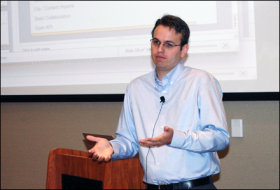Canvas-ing for a better online learning experience
Devlin Daley, co-founder and chief technology officer of Instructure, delivers the keynote address at last week’s CU Online spring symposium.
When CU Online issued a request for proposal to upgrade its learning management system (LMS), what they were hoping for was a better deal from their current vendors: eCollege, which facilitates online courses; and BlackBoard, which uses technology to connect people. After all, they’d been clients for about 18 years. To their surprise, they found one platform that stood out above the others.
On May 23, a record 180 faculty and staff took part in the 12th annual CU Online Spring Symposium, held at the new Spring Hill Suites Marriott on the Auraria Campus, to learn about the university’s new LMS, Canvas.
“We decided to consolidate to one, simpler experience for students and faculty,” said Crystal Gasell, from CU Online academic technology. “We will be reinvesting the money we saved into new technologies.”
The past year, CU Online conducted a 40-course pilot with faculty and students. “The faculty said, ‘Absolutely, move forward with Canvas. We don’t want to go back,’” Gasell said. “The students were indifferent, like, ‘Eh, whatever, just give me my login materials.’”
The login, said Michael Edwards, CU Online, already is substantially easier. “One problem with the other LMSs is the login was completely different,” he said, explaining that separate usernames and passwords were required for each account. “With Canvas, it’s the same as your (CU) username and the password is synched to change.”
Faculty will be given the option to opt-in to Canvas this summer; by fall almost all courses will be taught on Canvas and the old LMSs will be retired next spring. CU Online will migrate the content for faculty, and all eCollege and Blackboard courses will be accessible in an archive.
Canvas offers the same options as the previous vendors, including discussions, quizzes, announcements, gradebook and file sharing. New features include:
- text editor
- easy links
- easy photo additions and sizing
- options to link and add video
- universal updates -- such as updating a faculty profile once for all courses
- document upload preferences
- several chat and discussion choices
- the ability to view the course the way it is presented to the student
Boot camps will be offered -- with hot meals -- to help faculty and staff learn the new system, Edwards said.
Devlin Daley, co-founder and chief technology officer of Instructure, the creator of Canvas, was symposium keynote. Devlin said he and co-founder Brian Whitmer based the company on sound advice from a college professor who told them that when it comes to technology, don’t go after the money, rather find a need; find a way to change the world. They didn’t have to look far. Even as they searched for new ideas, they were hindered because their college’s LMS was “the worst.”
“At first we thought our school had made a very bad choice,” he said. “When we found out it was a very large corporation, very successful, we couldn’t believe it.”
Canvas doesn’t try to be slick, Daley said. It is meant to be highly functional and user-friendly, both for students and faculty. Canvas is an open-source platform, meaning the code is accessible to users at no cost. Higher education institutions are able to modify the code themselves or work with Instructure to create applications specific to their needs. Because it lives in the Cloud, Canvas can be upgraded seamlessly by Instructure without any disruption or need for updates by the users.
David Thomas, CU Online’s director of academic technology, said Canvas was an obvious choice.
“They’re leading because they really have a vision of where this stuff should go,” he said. “I think it really matches up with the values and ideas that we have.”


